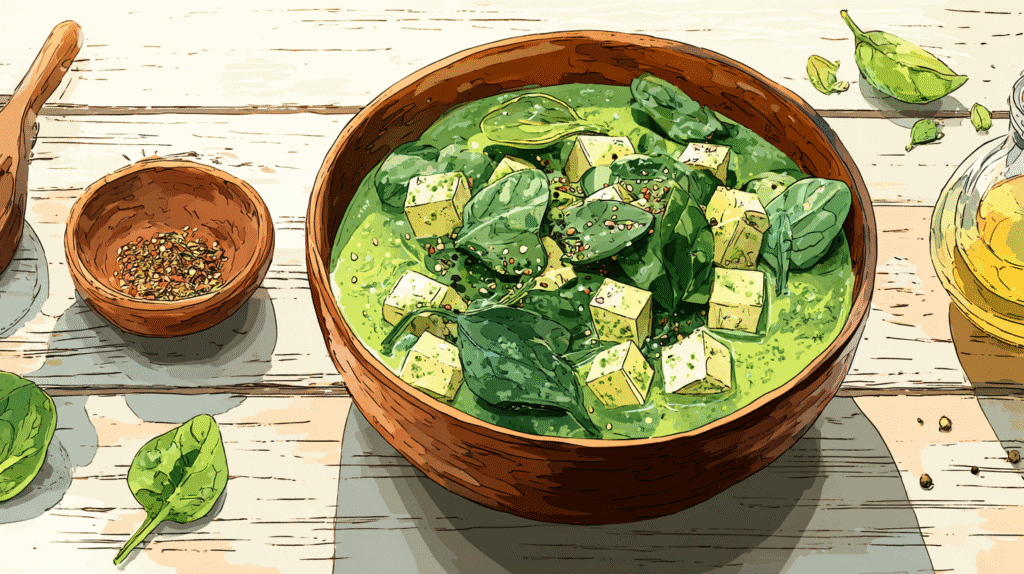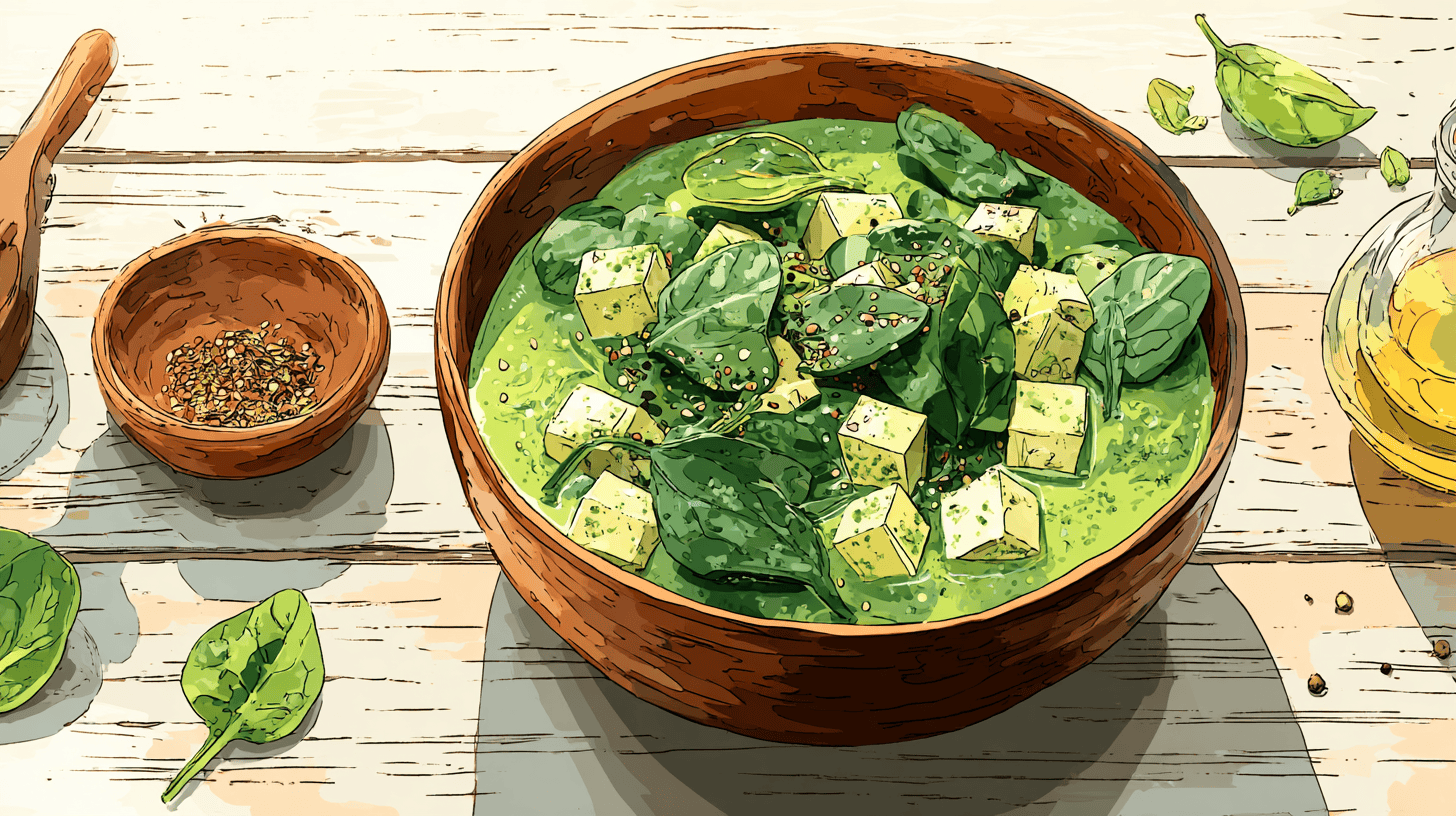Table of Contents
Can Diabetics Eat Saag Paneer? A Clear Guide on Its Benefits and Risks
Saag paneer is a classic Indian dish made with leafy greens and paneer, a soft, mild cheese. If you’ve got diabetes, you might be wondering if it’s safe to eat.
Saag paneer can actually be a solid choice for diabetics since it’s low in carbs and packs in a good amount of protein and nutrients.
The leafy greens bring fiber and vitamins that help keep blood sugar in check. Paneer offers protein and healthy fats, which don’t spike glucose levels.
Eating saag paneer in moderation, especially with other healthy foods, can help support balanced blood sugar.
Key Takeaways
- Saag paneer is low in carbs and high in protein, making it a good fit for diabetes.
- The dish is full of nutrients that help with blood sugar control.
- Moderation and balance are key for steady glucose levels.
Nutritional Overview of Saag Paneer
Saag paneer mixes nutrient-rich spinach with creamy cheese, giving you protein, fat, and a bunch of vitamins. The nutrition really depends on how much veggie, dairy, and cooking fat you use.
Key Ingredients in Saag Paneer
Spinach (or palak) and paneer are the stars here. Spinach brings iron, vitamin C, fiber, and minerals.
Paneer adds protein and calcium, but it’s not shy about the fat content.
Onions and tomatoes sometimes join in for flavor and a little extra nutrition. The oil or ghee you use matters, too—more oil means more calories.
If you’re watching fat, using low-fat milk in your paneer or sauce can help cut it down.

Macronutrients and Micronutrients
A typical serving of saag paneer gives you about 7–8 grams of protein, mostly from the paneer. There’s not much fiber since paneer doesn’t have any and spinach cooks down a lot.
Carbs are low—around 3 grams per serving—so it’s not likely to spike your blood sugar.
Spinach brings iron and vitamin C. Iron helps with energy, and vitamin C boosts iron absorption.
You’ll get calcium from the paneer, which is good for your bones.
Calorie and Fat Profile
Saag paneer has around 160 calories per serving. Most of the fat—about 13 grams—comes from the paneer and any oil or ghee you add.
If you want less fat, you can use less oil or swap in low-fat paneer.
A lot of the fat is saturated, so it’s smart to keep an eye on your portions. The calories mainly come from fat and protein, so the dish is filling but pretty dense.
Tweaking the ingredients can make it work for your goals, especially if you’re managing weight or blood sugar.
Health Considerations for Diabetics Eating Saag Paneer
Saag paneer brings together cooked greens and paneer cheese, making a dish loaded with protein, fiber, vitamins, and minerals. The way it affects your blood sugar depends on how you make and eat it.
Glycemic Impact of Saag Paneer
Saag paneer’s main ingredients give it a low glycemic impact. Paneer is low in carbs and doesn’t cause a blood sugar spike.
Spinach and other greens add fiber, which slows down digestion and helps keep blood sugar steady.
Because of the protein and fiber, saag paneer can support balanced blood sugar. Just don’t add sugar or starchy thickeners, as those can bump up the glycemic load.
Using less oil or ghee is also better for blood sugar.
Benefits and Risks for Blood Sugar Control
Paneer is a solid source of protein and calcium, with barely any carbs—a plus for diabetes. Spinach or palak offers iron and vitamin C, which helps your body absorb nutrients.
The fiber in greens helps manage blood sugar spikes.
If you use high-fat paneer or lots of oil or ghee, though, you’ll rack up calories fast. Eating too much or too often could make weight management trickier and might affect insulin sensitivity.
Recommended Modifications for Diabetic Diets
Here’s how to make saag paneer more diabetes-friendly:
- Go for low-fat paneer, or make your own from low-fat milk.
- Use fresh spinach or other leafy greens for fiber and nutrients.
- Keep added oil or ghee to a minimum, and try healthier oils if you want.
- Skip heavy cream or full-fat dairy to keep saturated fat down.
- Watch your portion sizes to avoid excess calories.
These tweaks help you keep the nutrition while supporting blood sugar and weight control.
Practical Tips for Including Saag Paneer in a Diabetic Meal Plan
You can definitely enjoy saag paneer with diabetes—it’s all about how you cook and serve it. A few smart choices go a long way.
Healthier Cooking Methods
Use as little oil as possible, or pick heart-healthy oils like olive oil or just a bit of ghee. Skip deep-frying the paneer; pan-fry lightly or bake it instead.
Try using low-fat milk instead of cream to cut down on saturated fat and calories.
Add spices like cinnamon or a splash of vinegar for flavor without extra calories or sugar. Go easy on the salt and avoid rich sauces.
Cooking with fresh spinach and simple spices keeps the dish both healthy and tasty.
Best Food Pairings
Pair saag paneer with high-fiber foods to slow down sugar absorption. Brown rice, whole-grain rotis, or legumes like chickpeas are all good picks.
A side salad or some fermented veggies adds vitamins and helps with digestion.
If you eat meat, a little grilled chicken or fish goes well without messing with your blood sugar. Try to avoid heavy or sugary sauces, and keep portions reasonable.
Eating Out and Restaurant Choices
When you’re out for Saag Paneer, always check how it’s made. Don’t be shy—ask if they can go easy on the oil or ghee.
Skip anything swimming in cream or butter sauce. It’s just not worth it.
Look for places that serve up fresh veggies or whole grains on the side. Brown rice or multigrain rotis are solid picks.
Fried appetizers? Maybe just say no. And honestly, alcohol can mess with blood sugar, so it’s smart to keep it minimal.
Watch out for restaurant sauces—they sneak in sugar or salt more often than you’d think. Stick to simple dishes, and if you can, ask for a little salad or some plain yogurt on the side. That way, you can balance things out a bit.
